 | Our Story |
During the era of Professor Kanae Maeda (1927 – 1941) †
The parent organization of the Institute for Chemical Research (ICR) was the Special Chemistry Laboratory of the School of Science. It was established in 1915 to research manufacturing methods of pharmaceuticals, whose import had been forced to cease due to World War I. In 1927, the institute expanded its research to “academic theories and applications of particular matters related to chemistry,” and the institute became the first adjunct research institute of Kyoto University. The institute started with eight laboratories back then, one of which was the Kanae Maeda Laboratory (medical chemistry). Since the ICR did not have its own building, the eight laboratories were housed separately in the faculties of science, engineering, medicine and agriculture. Principal investigators of the laboratories concurrently served as faculty professors (some were assistant professors). Professor Maeda was teaching the medical chemistry course of the Faculty of Medicine, and also became the ICR Professor. In 1935, he also became president of the Osaka Women’s Medical College. For two years from 1936, he served as the dean of the Faculty of Medicine of the Kyoto Imperial University, but resigned as professor of the Faculty of Medicine in 1941 when he was appointed as principal of the third high school under the old education system in Japan.
His laboratory mainly focused on the following themes: “research on particularity of enzymes” and “chemical research on endocrine secretion.” Their main focus was later shifted to “Chemical research on cells and filamentous bacterium.”
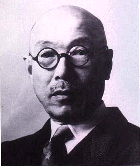 | 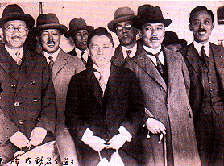 |
| Professor Kanae Maeda | Uchino leaving to study in Germany on March 31, 1929. Photo taken at send-off for Assistant Professor Senji. At center is Senji Uchino; to his right is Professor Kanae Maeda. |
During the era of Professor Senji Uchino (1932 to 1957) †
In 1929, the main building of the Institute for Chemical Research was completed in Kosobe, Iwate-mura aza, Mishima-gun, Osaka (current Takatsuki-shi, within the premises of Osaka Medical College). From this point on, full-time professors were assigned to the ICR. The first such professor was Professor Senji Uchino. He was an assistant professor of the Faculty of Medicine at the time, and just finished studying in Germany, France, and the United States. He was appointed in June 1932. The Uchino Laboratory within the ICR continued even while the Professor assumed a professor position at Tohoku Imperial University (1938 to 1941), and after returning to Kyoto Imperial University (medical chemistry) as a professor in December 1941. During this time, Professor Uchino served as director for the Kyoto University ICR from September 1948 to December 1953, and as dean of the Kyoto University Faculty of Medicine for two terms, or four years, from December 1952. In 1955 and 1956, the professor also served as the Kyoto University Deputy President in Administration while President Yukitoki Takigawa was abroad on business. From April 1951, he was also a professor at the Kyoto University Tuberculosis Research Institute. He retired in March 1957.
The main theme of the Uchino Laboratory had been, since its beginning, "biochemical (later, physiopathology) research on internal organs (tissues)," with researches on tumor tissues, phospholipids and proteolysis (enzymes and products) later being added.
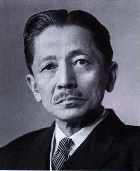 | 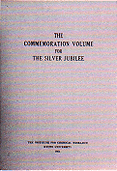 | 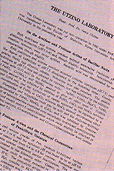 |
| Professor Senji Uchino | Uchino Laboratory Introduction text, published in 1952 Kyoto University. Institute for Chemical Research Report (25th anniversary commemorative issue) (Title indicates ongoing research on natto yeast). | |
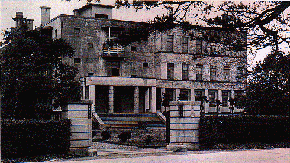 | 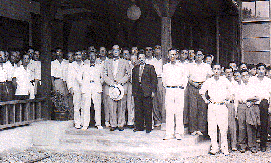 |
| Main gate and main building of the Institute for Chemical Research when it was located in Takatsuki. | Professor Senji Uchino and members of the Institute for Chemical Research standing with Doctor Hideki Yukawa. (Since it is inscribed "Welcoming Doctor Yukawa from Stockholm," the photo was probably taken in 1949). |
During the era of Professor Osamu Hayaishi (1959 to 1981) †
After Professor Uchino retired, Professor Osamu Hayaishi, head of the Toxicology Division of the National Institute of Health in the United States, was invited as professor of medical chemistry at the Faculty of Medicine, in 1958. Professor Osamu Hayaishi also took over the laboratory of the ICR in 1959, serving concurrently for two years as professor of the Chemistry I Course for the Osaka University Faculty of Medicine from 1961 and four years as professor of the Nutritional Science Course for the Tokyo University Faculty of Medicine from 1970. He was dean of the Kyoto University Faculty of Medicine for two years from 1979.
The Hayaishi Laboratory delivered splendid research results in a wide range of fields, including tryptophan metabolism, NAD biosynthesis and adjustment, as well as serotonin biosynthesis, poly (ADP-ribose) and ADP-ribosylation, oxygenase, threonine deaminase, pyrimidine biosynthesis, adenylate cyclase, etc. However, during the era of Professor Hayaishi, the medical chemistry classroom of the Faculty of Medicine was mainly used, and therefore, these experiments and researches were conducted by the Faculty of Medicine. In March 1981, the laboratories of the Institute for Chemical Research, where actual research was no longer underway, were returned to the Institute for Chemical Research and the medical chemistry laboratory of the Institute for Chemical Research was closed temporarily.
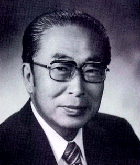 | 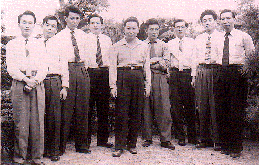 |
| Professor Osamu Hayaishi | At the time Professor Hayaishi assumed his post. In photo, from left, Mr. Yasutomi Nishizuka, Mr. Nobutomo Itada, Mr. Shigeru Hisano, Mr. Takashi Yanai, Mr. Osamu Hayaishi, Mr. Minoru Tashiro, Mr. Ryokuero Suzue, Mr. Masazumi Takeshita and Mr. Ryuichi Kimura. |
During the era of Professor Kunihiro Ueda (1994 to 2004) †
Ten years later, in 1993, when the Institute for Chemical Research was being reorganized into a large-division structure, the idea of reviving medical laboratories arose. Following the screening, Professor Kunihiro Ueda, from the medical chemistry course of the Kyoto University Faculty of Medicine, and assistant professor of laboratory medicine at the Faculty of Medicine, was selected as professor of the Institute for Chemical Research, taking charge of the new Biological Reaction Design Research Division III (biological reaction regulation domain) from April 1994. Professor Ueda taught student lectures on molecular biology and seminars, which were formerly taught in the medical chemistry classrooms. In other words, this was the rebirth of the medical chemistry laboratory of the Institute for Chemical Research in another form. Before and after his retirement in March 2004, Professor Ueda held such positions as Director of the Japanese Society of Genetic Diagnosis.
Research themes included genetic diagnosis, poly (ADP-ribose), Alzheimer's disease, and leukemia.
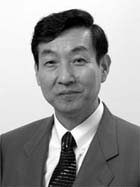 | 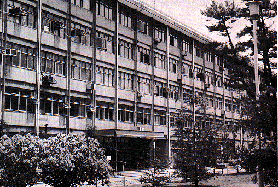 |
| Professor Kunihiro Ueda | Main building of the Institute for Chemical Research |
During the era of Professor Motonari Uesugi (2005 to present) †
After the retirement of Professor Ueda, Motonari Uesugi, an associate professor at the Department of Biochemistry & Molecular Biology at Baylor College of Medicine at the time, was appointed professor at the Institute for Chemical Research. The research field of Uesugi is called “chemical biology” in the United States. Chemical biology is a field of biology based on small-molecule organic compounds that offers a new perspective, with its research encompassing medicine and chemistry. Kyoto University boasts a brilliant tradition in the fields of medicine and chemistry. It is my wish to make contributions in research and education, in my own way, as a means of connecting these two outstanding fields. What we aim for is truly unique research to which researchers can devote their passion.
*This history description was created by editing articles sent in by Professor Kunihiro Ueda et al., in addition to other documents, for the magazine commemorating the centennial anniversary of the Kyoto University medical chemistry classroom. (Motonari Uesugi)
